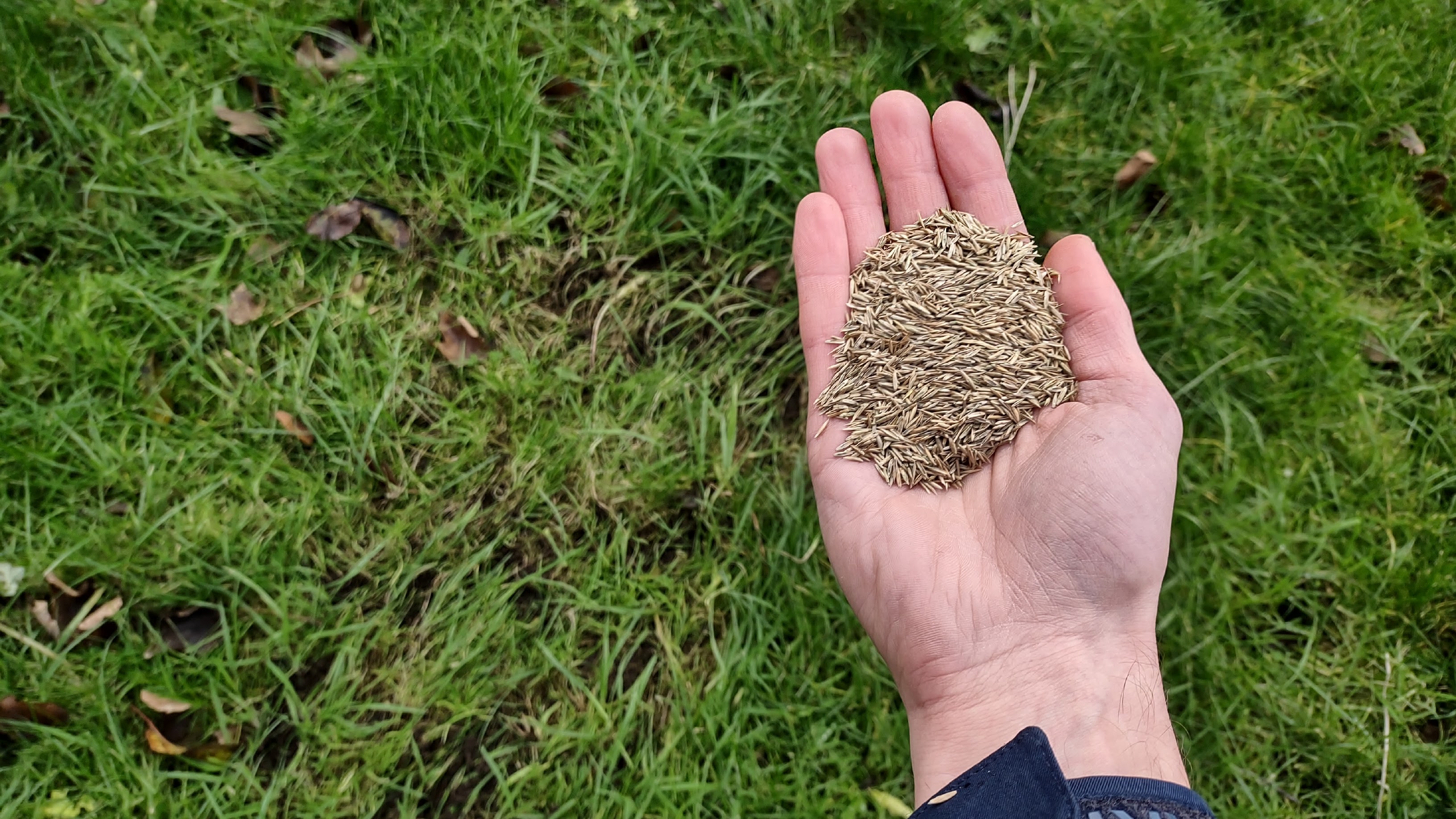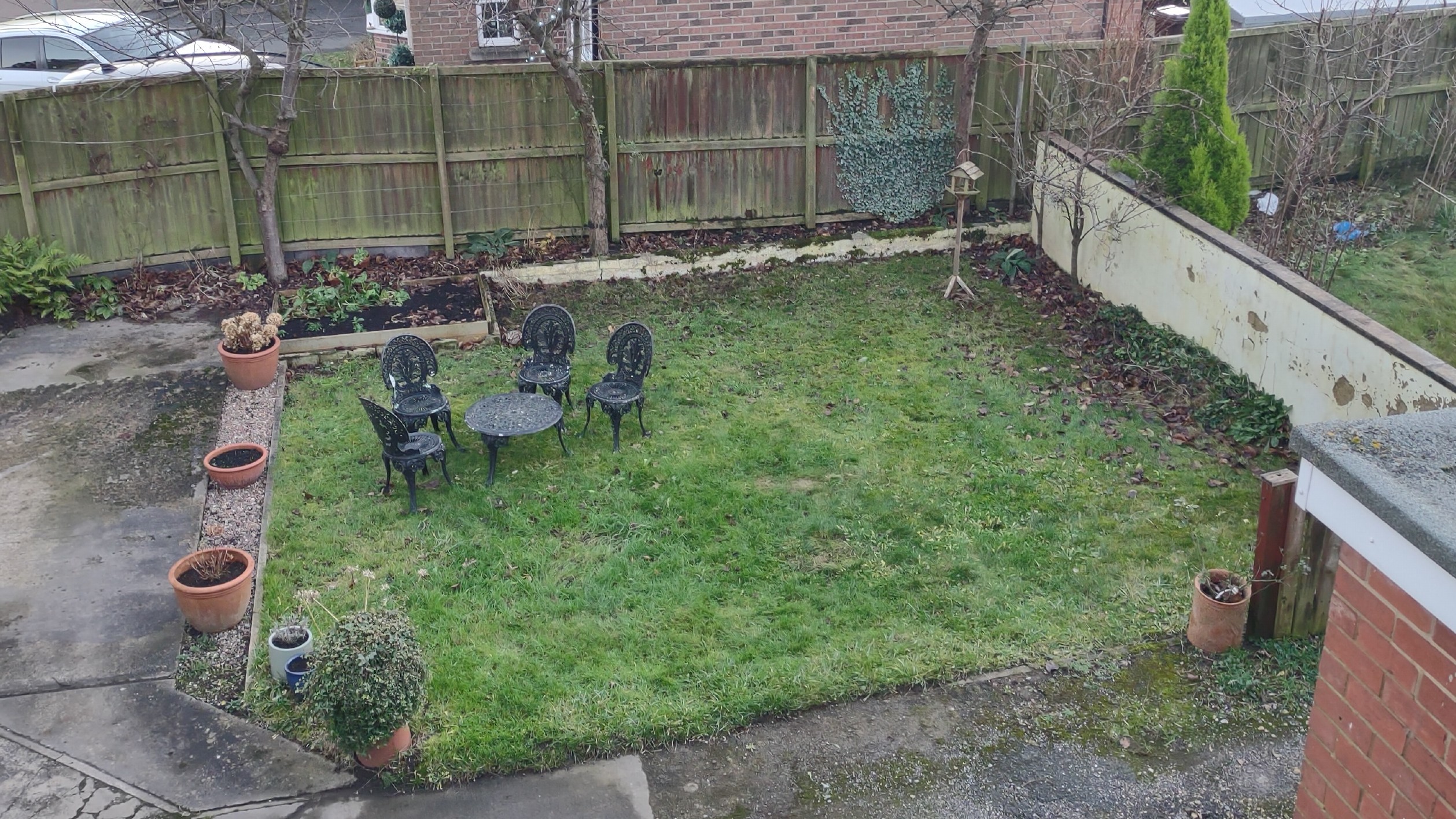
- Lawn mower (e.g. one of the best gas lawnmowers)
- Dethatcher (optional) like this electric dethatcher on The Home Depot
- A seed spreader (optional) such as this one on The Home Depot
- Fast-growing grass seed (shop Amazon)
- Watering can OR a sprinkler system just like the Aqua Joe SJI-OMS16 Oscillating Sprinkler with Adjustable Spray (Amazon)
Let’s start by saying that winter is probably not the best time to sow grass seed in your yard. However, if you know how to grow grass seed and when to sow grass seed at the right moment, it’s possible to sow successfully in winter.
There are a few reasons why you might choose to sow lawn seed in the wintertime. Weeds may have taken root – and if you’re going to uproot these unwelcome guests, then you’ll need to replenish the vacated soil with grass. Or, your aim might be fixing patchy grass that got trodden all over in the summer.
Overseeding has a special role in some places which generally have a warmer climate, such as the southern third of the continental United States. In these areas, lawns are often mainly composed of warm-season grasses like bahiagrass, which look great in summer but tend to turn a dull color in the winter. If this sounds like your situation, then you can overseed with winter-resistant cold-season grasses in early winter as a way to keep the lawn looking green and pleasant during those darker days.
According to Peter Chandler, Managing Director of Cobra Lawn Machinery, overseeding is particularly useful for thickening lawns and encouraging healthy growth.
“It can encourage a thicker, more vibrant lawn as it fills in any bare or damaged patches of grass, helping to improve its overall appearance while reducing the amount of weeds and moss,” says Peter.
“It’s also a great way of filling any sparse areas that may have had excessive wear and tear or damage over the summer from garden parties, children playing or, this year in particular, heat.”
If this sounds like the type of sowing you'll be doing, it could be worth refreshing yourself on how to overseed a lawn. With that said, not just about overseeding – some intrepid gardeners sow entire new lawns in the wintertime. This guide will talk you through how to sow grass seed at winter, whichever of the two goals you’re aiming to accomplish.
Quick steps to sowing grass seed
- Wait for the right moment. Don’t sow the seed when it’s very wet or very cold.
- Prep the area for seeding. Remove debris and thatch. Consider mowing. (Or rake the soil deeply if sowing a whole new lawn.
- Sow the grass seed. A fast-growing, cold-weather seed is best.
- Water the area. Cover the whole lawn with a fine spray.
- Keep watering for six weeks. And avoid stepping on the seedlings during that time!
Step by step guide: How to sow grass seed
1. Wait for the right moment

Sowing grass seeds in winter is always going to come with less assurance of success than doing so in spring. However, you can improve your chances by choosing your moment carefully.
Grass is more likely to germinate successfully when the ground temperature is over 43℉ (and preferably a little warmer). The good news is that the soil tends to be a little warmer than the air is. Stick a thermometer (like this one on Amazon) into the soil and check the situation. If the soil is cooler than 43℉, your best bet might be to wait for warmer conditions.
I waited a few weeks of very cold, wet weather before a suitably mild spell came along.
2. Prep the area for seeding

Remove materials that could prevent grass seeds from finding their way to the soil. If overseeding an existing lawn, remove fallen leaves. Also, consider mowing and lightly dethatching the lawn to remove some of the thatch that will have accumulated between grass blades. This electric dethatcher on The Home Depot would do it.
If you’re seeding a new lawn, you’ll need to take some extra steps. Remove debris such as gravel and weeds, and rake the soil to a depth of approximately 3 to 4 inches before sowing. The soil should be moist – so, if the weather has been dry lately, water the area lightly.
I was only overseeding some patchy areas, so I decided just to dethatch the lawn, rather than mowing the entire lawn.
3. Sow the grass seed

Sprinkle your grass seed onto the areas of the lawn where you’d like new grass to grow.
I did this by hand, which I find to be the best way to get an even spread of seeds. However, if you have a big area to cover, you might benefit from using a spreader tool (like this one on The Home Depot) instead.
You should be aiming to sow around 1 lb of seed per 30 square yards of lawn area. The coverage should be quite dense, with roughly 10-20 seeds per square inch.
4. Water the lawn

Water the lawn finely but thoroughly, using a watering can or sprinkler. You don’t want to waterlog the new seeds, so you should aim to make the ground moist, not saturated.
This two-gallon watering can from Amazon would help or, if you have a larger area, the Aqua Joe SJI-OMS16 Indestructible Metal Base Oscillating Sprinkler with Adjustable Spray (also Amazon) would cover it.
5. Keep watering for six weeks

The seeds should be kept moist for at least six weeks after sowing. So, on days when it doesn’t rain, take a moment to water the grass.
With that said, you should avoid walking on the grass during this time. It might be a good idea to water from a distance, using a tool such as a hosepipe with a spray nozzle.
FAQs
Can you just sprinkle grass seed on lawn?
Sprinkling grass seed on the lawn is certainly an important part of the sowing process – but there’s a little more to it than that. For a start, you’ll need to prepare the area as outlined in the step-by-step guide above, by removing materials such as fallen leaves and thatch.
Once you’ve fully prepped the area, you can sprinkle over the grass seed by hand. Or, if you want to take the effort out of seeding a large area, you can use a tool such as a spreader. In order to achieve healthy, even growth, the seeds should be spread at a density of about 10-20 per square inch.
Can you use too much grass seed?
Yes, you can use too much grass seed during sowing. If you exceed a density of around 20 grass seeds per square inch, then the closely packed seedlings might end up competing against each other for an inadequate supply of water, nutrients and light.
Densely seeded grass can often grow well at first, but in the long term it is likely to succumb to turf disease. Meanwhile, you’ve used up more grass seed than you needed to.
How sure can I be that sowing grass seed in winter will work?
Not very sure. Sowing grass seed in the winter is a speculative measure, rather than a sure-fire ticket to a flourishing lawn. If the weather suddenly gets much colder, soon after you sow, then the new grass seed might not germinate successfully.
The good news is that attempting to sow grass seed in the winter will not impair future attempts to sow a lawn on the same ground, so you can always try again in spring if it doesn’t work out this time around. Of course, you’re potentially taking a hit on the cost of the seed.







